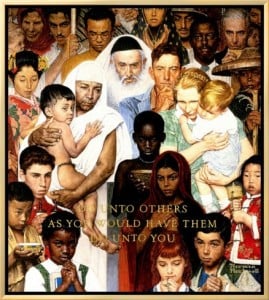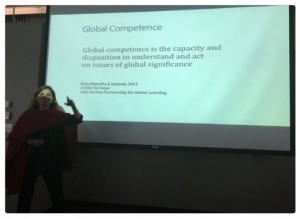George Bernard Shaw said “You see things; and you say ‘Why?’ But I dream things that never were; and I say ‘Why not?’ Last week I had the pleasure of engaging with this, in essence, leadership style/belief with a group of educators at the Global Education Think Tank at Harvard’s Graduate School of Education. Participating in this symposium fulfilled a professional and personal goal I had made for myself in 2010 w hen the event first came on my radar. For making this a reality, I am forever grateful to both Dr. Reimers and Dr. Fletcher for inviting me to be part of a panel discussion. It was a transformative experience.
hen the event first came on my radar. For making this a reality, I am forever grateful to both Dr. Reimers and Dr. Fletcher for inviting me to be part of a panel discussion. It was a transformative experience.
Over the course of three days about 90 participants engaged “in the active and critical examination of global competency and the practice of global education.” Below, I have captured highlights of the program – my main takeaways and some resources that were shared. Additionally, the twitter feed for the event can be found here.
I hope you find the items below enlightening, inspiring, and catalysts for reflection about your school’s and personal educational philosophy. As Marcel Proust noted “The real voyage of discovery consists not in seeking new lands but seeing with new eyes.” Enjoy!
1) Sustainable Development Goals (Fernando Reimers)
- Main Takeaways There is power in clearly articulating the purposes of education. In our connected and diverse world, global education provides the most relevant framework for educators to express the change in values that come with globalization. Therefore. what we choose to say and do in the spirit of global education, both as an avenue for reflection on teaching and learning as well as a driver for change in those areas, matters. Three ways to implement global education in schools include a) Designing new instructional practices b) Develop new curriculum c) Change the culture of teachers and students. Additionally, it is important
 to recognize student development and success happens cognitively and in their interpersonal and intrapersonal capabilities. The UN Sustainable Development Goals offer set of authentic, global issues that schools can use to develop learning experiences for students. Developing a curriculum, instructional practices, authentic assessments, and teacher development programs wouldn’t simply change education – it would transform it.
to recognize student development and success happens cognitively and in their interpersonal and intrapersonal capabilities. The UN Sustainable Development Goals offer set of authentic, global issues that schools can use to develop learning experiences for students. Developing a curriculum, instructional practices, authentic assessments, and teacher development programs wouldn’t simply change education – it would transform it.
- Resources to Explore 17 Goals to Transform the World The World Course Presentation at UNESCO 2015 UN Declaration of Human Rights
2) Six Strategies for Advancing Global Education (Brandon Wiley)
- Main Takeaways What will the world (and school) be like in 2028? The current landscape provides insights to that question. a) Globalization is not a fad b) The world is becoming more diverse c) More significant than what you know is what you do with that knowledge. So, how can schools embrace global education? It is important to remember that frameworks (and vision statements) are only as good as their application. So, it is necessary to support your assets and recognize your access points in curriculum, instruction, assessments, and staff.
- Resources to Explore Global Ed Leader Asia Society Education
3) How to Promote and Assess Intercultural Competency (Darla Deardorff)
- Main Takeaways What are some of the answers to the question “Why should we emphasize global education in our school?” In other words, what are the benefits of fostering skills and dispositions like Intercultural Competence and International Mindedness? Some of the popular answers include a) Employability b) Integration of immigrants and “the Other” and c) Develop principles of democracy. Furthermore, the session reminded us that the PISA tests will begin to assess “Global Competency” in 2018
- Resources to Explore PISA Global Competency Recent Article on Global Competence Being Tested
4) How do you Address Religious Literacy (Ali Asani)
- Main Takeaways The guiding question to this session “What influences our understanding about the world,
 people, belief systems, and culture?” centers our work in global education. Focusing on religious literacy, Dr. Asani challenged the claims of Samuel Huntington’s “clash of civilization” theory which groups people of the world into monolithic, static, packaged units of existence. The result is a limited understanding about and a simplistic “othering” of people not like you. Aptly, Dr. Asani references this as a “Clash of Ignorance” Returning to the core question, reflect on where your body of knowledge regarding Islam and Muslims comes from. Specifically, how often is Islam approached from an aesthetic epistemology? Maybe a better question is, why is it not?
people, belief systems, and culture?” centers our work in global education. Focusing on religious literacy, Dr. Asani challenged the claims of Samuel Huntington’s “clash of civilization” theory which groups people of the world into monolithic, static, packaged units of existence. The result is a limited understanding about and a simplistic “othering” of people not like you. Aptly, Dr. Asani references this as a “Clash of Ignorance” Returning to the core question, reflect on where your body of knowledge regarding Islam and Muslims comes from. Specifically, how often is Islam approached from an aesthetic epistemology? Maybe a better question is, why is it not?
- Resources to Explore Sa’adi Persian Poet Jalāl ad-Dīn Muhammad Rūmī Abdul Qādir Bēdil
5) How to Study Abroad with Limited Resources (Joey Lee)
- Main Takeaways Is international travel essential for a successful global education program? No. But schools may avoid even exploring the possibility because of a fear that it may be accessible to only a specific segment of the student body. Enter Education First (EF). In addition to the range of services related to global education. EF has intentionally moved from a tour(ist) model for students to one that immerses students in the country they visit. The result is a broader perspective (not the food. festival, clothing approach to global ed) and a maturing experience for students that develops global citizenship skills.
- Resources to Explore EF Travel Out of Eden Classroom
6) Using Design Thinking to Develop Curriculum in Global Education (Karina Baum and Gustavo  Carrera)
Carrera)
- Main Takeaways Buckingham, Brown, and Nichols has intentionally created a globally focused curriculum for their students. Using Design Thinking to map out challenges and possibilities, the school seeks input from a range of stake holders. The result is a “future oriented and forward thinking” curriculum. BB and N offers “Russian, Chinese, and Arabic as well as more commonly taught languages. Students also have access to a number of school exchange or international travel opportunities to locales that include Paris, Moscow, and Morocco. You can also study for a semester on the coast of Maine, in the city of Rome, or in the mountains of Colorado (or the Swiss Alps!).”
- Resources to Explore BB&N Multiculturalism BB&N Semester Away BB&N Trips
7) Developing Capacity Through Teacher Education (Veronica Boix Mansilla)
- Main Takeaways Teacher preparation in global education, both for pre-service teachers and veterans, must be clear and intentional. But what should the training/development focus on and look like? One approach is to focus on the concept of signature pedagogies. Lee Shulman defines this as “the types of teaching that organize
 the fundamental ways in which future practitioners are educated for their new professions.” In turn, this begs the question “what instructional practices are central to global education?” This is an exciting area to explore. Currently, Dr. Boix-Mansilla has identified these: a) Integrating Global Topics and Perspectives Into and Across the Standard Curriculum b) Authentic Engagement with Global Issues c) Connecting Teachers’ Global Experiences, Students’ Global Experiences, and the Curriculum. Additionally, comparative approaches are part of the signature pedagogies. In my experience, teachers who utilize video conferencing so their students can engage in dialogue with students around the globe is a signature pedagogy that easily used with projects like the Tony Blair Foundation.
the fundamental ways in which future practitioners are educated for their new professions.” In turn, this begs the question “what instructional practices are central to global education?” This is an exciting area to explore. Currently, Dr. Boix-Mansilla has identified these: a) Integrating Global Topics and Perspectives Into and Across the Standard Curriculum b) Authentic Engagement with Global Issues c) Connecting Teachers’ Global Experiences, Students’ Global Experiences, and the Curriculum. Additionally, comparative approaches are part of the signature pedagogies. In my experience, teachers who utilize video conferencing so their students can engage in dialogue with students around the globe is a signature pedagogy that easily used with projects like the Tony Blair Foundation.
- Resources to Explore Research Article Video on Global Competence
8) How to Lead a System-Level Strategic Initiative (Bella Wong and Craig Perrier)
- Main Takeaways
Bella and I offered perspectives from two very different educational scenarios. Bella is the Superintendent and Principal of Lincoln-Sudbury Regional High School with an enrollment of about 2,000 students. I am the h igh school social studies curriculum/instruction specialist for Fairfax County Public Schools. FCPS is 10th largest school district in the US with nearly 190,000 students and about 550 High School Social Studies teachers. Driving our strategic changes are commitments to global citizenship. Lincoln-Sudbury has a unique Global-Scholar Program for students to opt in. It develops students who are “active participants in our global community, while also demonstrating an appreciation for the importance of cultural diversity and global responsibility.” FCPS’ vision statement includes the development of Ethical and Global Citizenship as part of students’ K-12 experiences. Despite the size differences and out different positions, we agreed that it is imperative for global education leaders to do the following: a) Consistent and Clear Communication b) Collaboration Among Departments c) Nurture and Celebrate Teacher Leaders d) FInd Entry Points in Curriculum, Instruction, and Assessment.
igh school social studies curriculum/instruction specialist for Fairfax County Public Schools. FCPS is 10th largest school district in the US with nearly 190,000 students and about 550 High School Social Studies teachers. Driving our strategic changes are commitments to global citizenship. Lincoln-Sudbury has a unique Global-Scholar Program for students to opt in. It develops students who are “active participants in our global community, while also demonstrating an appreciation for the importance of cultural diversity and global responsibility.” FCPS’ vision statement includes the development of Ethical and Global Citizenship as part of students’ K-12 experiences. Despite the size differences and out different positions, we agreed that it is imperative for global education leaders to do the following: a) Consistent and Clear Communication b) Collaboration Among Departments c) Nurture and Celebrate Teacher Leaders d) FInd Entry Points in Curriculum, Instruction, and Assessment.
- Resources to Explore Our Presentation Bella’s Corner Globalizing US History
As you introduce or continue to develop your global education program, I encourage you to revisit, utilize and share these resources. Remember, hubris can prevent change in educators. But this can’t be allowed to hamper the evolution of teaching and learning from which our students will benefit.


From Karachi Pakistan, please accept my congratulations and thanks for an excellent piece or writing! Truly inspiring and eye opening! May I pass this on to interested educationists through my website? Thanks in advance!
Abbas Husain
Hi Abbas,
Thank you. Yes please share far and wide!